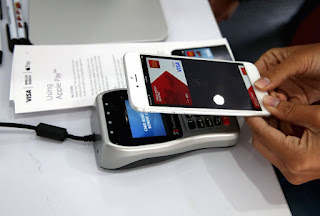Apple isn't shy about taking great features from Android, its number-one rival in smartphones and tablets.
That's not necessarily a bad thing — it shows Apple is willing to adapt to customer demand. By doing that, it's giving people more incentive to switch from Android to the iPhone. In fact, Tim Cook couldn't stop talking about "switchers" — people switching from Android to the iPhone — during the company's most recent earnings call in April.
This trend has become more evident in recent years than ever before. Here's a look at the features Apple has "borrowed" from Android over the past year. Apple is bringing split-screen multitasking to the iPad, which some Android devices have had for years.
1.Apple is bringing split-screen multitasking to the iPad, which some Android devices have had for years.
With iOS 9, which debuts in the fall, you'll be able to view two apps alongside one another on the iPad thanks to a new feature called Split View.
Both LG and Samsung have been offering split screen multitasking on their Android phones and tablets for ages. On certain Samsung devices, you can open more than one app on the home screen and resize them with a feature called Multi-Window. LG has a similar feature called QSlide that also lets you tweak the transparency of each window, too.
2.Siri is becoming more like Google Now.
One of the biggest improvements coming to iOS 9 is a more contextual version of Siri. Apple's virtual assistant will now be able to communicate with the apps on your phone to offer suggestions.
This is something Android's Google Now has been doing for a while — Google Now learns more about you the more you use it, and makes suggestions for you based on your habits.
3.Apple Maps is getting public transit directions, just like Google Maps.
4.You'll be able to move videos to the lower corner of your iPad's screen while using other apps.
Another new feature to debut with iOS 9 is Picture in Picture, which is exactly what it sounds like. When you're in a Facetime call or when you're watching a video, you'll be able to minimize that video so that it only takes up the bottom corner of your screen. This allows you to check your email, send a text message, or look at your Facebook without having to interrupt the video.
LG introduced a similar feature called QSlide to its G2 Android phone back in 2013. It lets you resize apps and move them around the screen. You could do this with a video to get the same effect as Picture in Picture.
5.With iOS 9, your iPhone will suggest apps it thinks you want to use. Android launchers that can do this already exist.
A new feature in iOS 9 allows your iPhone to guess which apps you want to use based on your habits. So, for instance, if you listen to music on your way to work, your iPhone might automatically launch Apple Music or Spotify when you plug in your headphones in the morning.
It's not a direct comparison, but Android launchers such as Aviate already offer a similar experience. Aviate presents apps and information that it thinks are relevant to you at certain times during the day. HTC's new phone, called the One M9, also comes with a feature that displays different apps that may be relevant to you based on your location.
6.Apple Pay will soon be able to store loyalty cards from your favorite stores, which Google Wallet has always done.
When iOS 9 debuts this fall, it will let you keep your store credit cards and loyalty cards within the app, eliminating Passbook. Google Wallet already offers this capability.
7.The iPhone 6 is Apple's first phone with an NFC chip, which means you can tap it to make payments instead of using a credit card. Android phones have had this feature for years.
The iPhone 6 and 6 Plus both come with NFC support, or Near Field Communication, which means you can tap your phone against certain payment terminals to buy things rather than using cash or a credit card. Android phones have had this feature for years, even though mobile payments haven't really taken off just yet. Phones from as far back as 2012, such as the Samsung Galaxy S3, have NFC built-in.
8.Apple added widgets to the iPhone last fall in iOS 8, which Android phones have had since around 2009.
Widgets are essentially interactive app icons that update to show you relevant information. For example, a weather widget would change throughout the day to show you the accurate temperature as it changes. Apple introduced widgets to iOS last fall with iOS 8, but they're a little different than the ones you'll find on Android.
iOS widgets live in your notification drawer, while Android widgets can be placed and resized anywhere on the home screen. According to Android's version history, it looks like widgets were introduced with version 2.0 Eclair, which debuted around 2009.
9.Apple also added the ability to summon Siri without touching your iPhone last year. Motorola's Moto X was already able to do that with Google Now.
Another feature that debuted with iOS 8 last year was the ability to launch Siri by simply saying "Hey Siri" instead of having to hold down the Home button on your iPhone. Motorola's Moto X, which launched in 2013, has a similar and more advanced version of this feature. Since the Moto X has a natural language processor inside, you can talk to the phone naturally from a distance without having to press any buttons or turn on the phone's display.












No comments:
Post a Comment